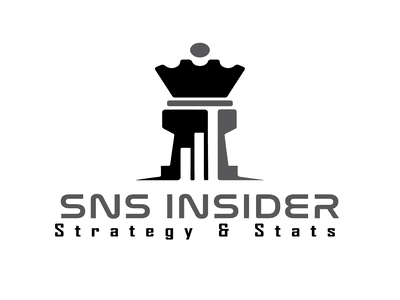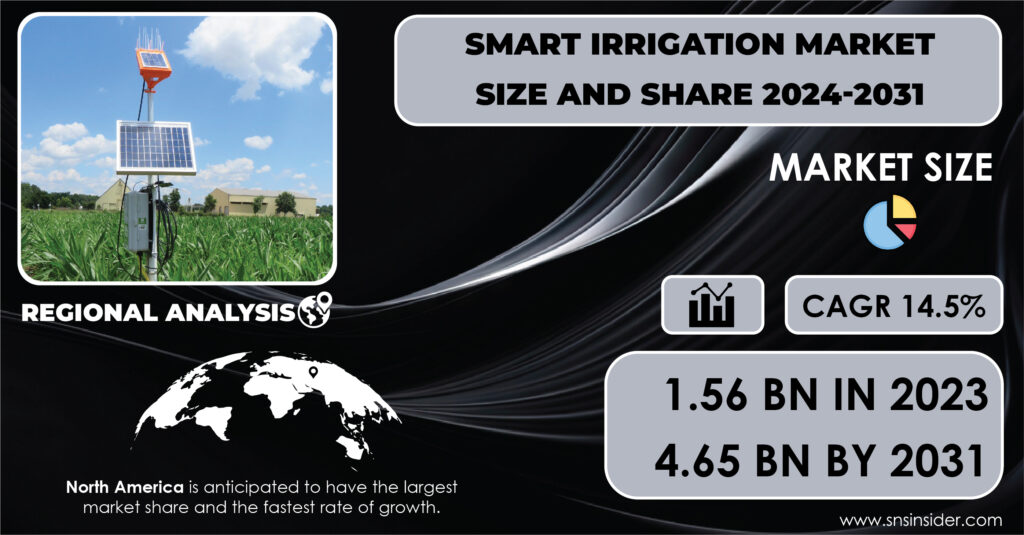
The Smart Irrigation Market size was valued at USD 1.56 billion in 2023 and is expected to reach USD 4.65 billion by 2031, reflecting a Compound Annual Growth Rate (CAGR) of 14.5% over the forecast period of 2024-2031, As Per report by SNS Insider.
Growing Demand for Smart Irrigation Systems
The smart irrigation not only prevents overwatering but also minimizes energy consumption associated with pumping water. Smart irrigation fosters a sustainable environment by promoting responsible water use and resource preservation. The Advanced technologies integrate seamlessly with existing irrigation systems, offering automation, monitoring, and data analysis capabilities. This translates to reduced water waste, timely leak detection, and proactive alerts for potential issues.
The Need for Efficiency in Agriculture Drives Market Expansion
In the agricultural sector, traditional irrigation methods can result in significant water loss (around 50%) due to inefficiency. Smart irrigation systems address this challenge by employing sensors for real-time monitoring of watering routines. Moreover, these systems help farmers optimize utility costs by reducing water usage, translating into significant savings on water bills. With the rising popularity of precision farming techniques and the imperative for water conservation, the smart irrigation market is poised for rapid growth in the agricultural sector.
Get Free Sample Report of Smart Irrigation Market @ https://www.snsinsider.com/sample-request/3380
Top Companies Featured in Smart Irrigation Market Report:
- Rain Bird Corporation (US)
- The Toro Company (US)
- Hunter Industries (US)
- Netafim (Israel)
- HydroPoint (US)
- Manna Irrigation (Israel)
- Stevens Water Monitoring Systems (US)
- Galcon (Israel)
- Rachio (US)
- Weathermatic (US)
Government Initiatives and Technological Advancements Propel Market Growth
Several factors contribute to the Growing market share of smart irrigation. Government initiatives play an important role by offering rebates and subsidies, encouraging the adoption of this innovative technology. Increased awareness among farmers about the advantages of smart irrigation, such as higher crop yields and reduced fertilizer waste, further fuels market expansion. The advancements in sensor technology, coupled with the growing acceptance of IoT-based irrigation systems, are propelling market growth. Government programs supporting sustainable agricultural practices act as another growth catalyst.
Smart Irrigation Industry Segmentation as Follows:
By Component
- Controllers
- Sensors
- Water Flow Meters
- Others (includes gateways, routers, and wireless communication equipment)
By System Type
- Weather-based
- Sensor-based
by System Type, The rapid advancement in wireless technologies is a key driver for the sensor segment within the smart irrigation market. The increasing deployment of soil moisture sensors, rain sensors, and fertigation sensors is expected to fuel growth in this segment due to their ability to automate irrigation scheduling in agricultural settings. Soil moisture sensor-based controllers, using established technologies, accurately determine soil moisture levels and transmit this data to the controller, enabling optimal irrigation management.
By Application
- Agricultural
- Greenhouses
- Open-fields
- Non-Agricultural
- Residential
- Turf & Landscape
- Golf Courses
- Others
by Application, The agriculture application segment of the smart irrigation market is anticipated to witness the fastest growth rate during the forecast period. This growth is attributed to the growing emphasis on maximizing farm productivity and profits through the adoption of smart irrigation solutions. Farmers are increasingly recognizing the benefits of this technology, enabling them to optimize water usage and yield higher crop yields while maintaining crop quality. Smart irrigation offers an accurate prediction of crop water requirements, leading to efficient water management in open-field crop production, a crucial factor for modern and sustainable agriculture. The trend of indoor farming is another growth driver. This trend is Driven by changing consumer preferences, supportive government regulations, attractive incentives offered for smart greenhouse irrigation technologies, and the rising demand for food due to a rapidly growing global population.
Ask Your Query Before Buying this Research Report @ https://www.snsinsider.com/enquiry/3380
Recent Developments in the Smart Irrigation Market
- February 2022: Netafim USA, a leading irrigation solutions provider, launched the AlphaDiscTM filter. This innovative product safeguards irrigation systems from clogging caused by organic contaminants.
- 2021: The Toro Company acquired Left Hand Robotics Inc., a move that strengthens Toro’s position in developing automated solutions for improved operational efficiency.
- August 2021: A collaborative effort between the United Planters’ Association of Southern India (UPASI), irrigation giants Jain Irrigation Systems and NaanDanJain Irrigation, along with the Israeli Consulate General in South India, saw the launch of the Smart IoT Irrigation Project in a tea plantation located in Ooty, Tamil Nadu. This project leverages an Israeli-developed smart irrigation system to enhance crop productivity while minimizing water consumption.

Impact of Global Disruptions
The war in Ukraine has disrupted global supply chains, impacting the availability and pricing of raw materials used in the production of smart irrigation components. This could result to temporary price fluctuations and potential delays in the production and delivery of smart irrigation systems. This Results in increased prices for essential components such as semiconductors and plastics, impacting the overall cost of smart irrigation systems. During economic downturns, farmers might be forced to tighten their budgets, potentially delaying or postponing investments in new technologies such as smart irrigation systems. In times of economic hardship, governments might be compelled to cut back on subsidies and incentives offered for sustainable agricultural practices, including smart irrigation technology adoption. This could discourage farmers from adopting these solutions, impacting market expansion.
Key Regional Developments
– North America is witnessing significant growth in the smart irrigation market due to several factors The region has a long history of adopting advanced agricultural and non-agricultural technologies, including smart irrigation systems. This has fostered a strong market base for these solutions. The presence of large-scale farms in North America creates a suitable environment for the implementation of smart irrigation systems. These systems can automate irrigation tasks over vast areas, minimizing human intervention and optimizing water usage.
– The Asia Pacific region is anticipated to witness substantial growth in the smart irrigation market, Many countries in Asia Pacific face water scarcity challenges. This has Increased awareness about the need for water conservation, driving the adoption of smart irrigation solutions. Governments in the region are increasingly recognizing the importance of sustainable water management practices. They are implementing policies and offering incentives to encourage the adoption of smart irrigation technology.
Key Takeaways for the Smart Irrigation Market Study
- This report offers valuable insights into the smart irrigation market, highlighting key trends, growth drivers, and challenges.
- Water scarcity concerns are propelling the growth of the smart irrigation market as these systems offer efficient water management solutions.
- Advancements in sensors, IoT integration, and automation are driving the development of increasingly sophisticated and user-friendly smart irrigation systems.
- Government initiatives through subsidies and regulations are fostering the adoption of smart irrigation, and promoting sustainable agricultural practices.
- North America is a well-established market, the Asia Pacific region holds immense potential for future growth due to rising water scarcity and government support.
Major Key Points from Table of Content
1. Introduction
2. Research Methodology
3. Market Dynamics
4. Impact Analysis
5. Value Chain Analysis
6. Porter’s 5 forces model
7. PEST Analysis
8. Smart Irrigation Market Segmentation, By Component
9. Smart Irrigation Market Segmentation, By System Type
10. Smart Irrigation Market Segmentation, By Application
11. Regional Analysis
12. Company Profile
13. Competitive Landscape
14. USE Cases and Best Practices
15. Conclusion
Continued….
Access Detailed Research Insight with Full TOC and Graphs @ https://www.snsinsider.com/reports/smart-irrigation-market-3380
About Us:
SNS Insider has been a leader in data and analytics globally with its authentic consumer and market insights. The trust of our clients and business partners has always been at the center of who we are as a company. We are a business that leads the industry in innovation, and to support the success of our clients, our highly skilled engineers, consultants, and data scientists have consistently pushed the limits of the industry with innovative methodology and measuring technologies.
Contact Us:
Akash Anand – Head of Business Development & Strategy
Phone: +1-415-230-0044 (US)
Information contained on this page is provided by an independent third-party content provider. Binary News Network and this Site make no warranties or representations in connection therewith. If you are affiliated with this page and would like it removed please contact [email protected]



Comments